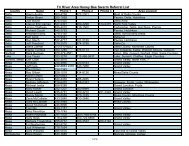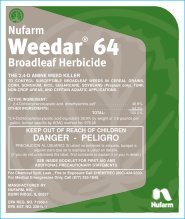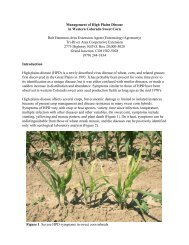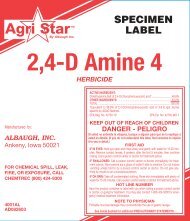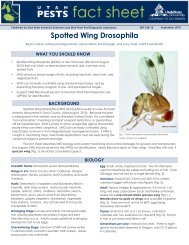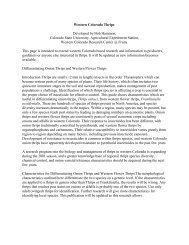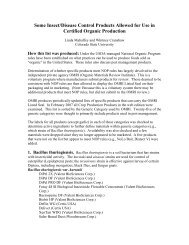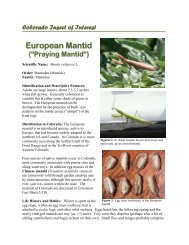Brown Marmorated Stink Bug - A New Exotic Insect in ... - Maine.gov
Brown Marmorated Stink Bug - A New Exotic Insect in ... - Maine.gov
Brown Marmorated Stink Bug - A New Exotic Insect in ... - Maine.gov
Create successful ePaper yourself
Turn your PDF publications into a flip-book with our unique Google optimized e-Paper software.
FS002<br />
Fact sheet<br />
www.rce.rutgers.edu<br />
<strong>Brown</strong> <strong>Marmorated</strong> <strong>St<strong>in</strong>k</strong> <strong>Bug</strong> —<br />
A <strong>New</strong> <strong>Exotic</strong> <strong>Insect</strong> <strong>in</strong> <strong>New</strong> Jersey<br />
George C. Hamilton, Extension Specialist <strong>in</strong> Pest Management & Peter W. Shearer, Extension Specialist <strong>in</strong> Tree Fruit Entomology<br />
The <strong>Brown</strong> <strong>Marmorated</strong> <strong>St<strong>in</strong>k</strong> <strong>Bug</strong>,<br />
Halyomorpha halys (Ståhl), is an exotic <strong>in</strong>sect<br />
belong<strong>in</strong>g to the order Hemiptera or true<br />
bugs. Halyomorpha halys, sometimes also called the<br />
yellow-brown st<strong>in</strong>k bug or East Asian st<strong>in</strong>k bug, is native<br />
to Asia and is considered an important agricultural pest <strong>in</strong><br />
Japan where it attacks soybeans and various tree crops.<br />
It was first collected <strong>in</strong> the United States just across the<br />
Delaware River <strong>in</strong> Allentown, PA dur<strong>in</strong>g the fall of 1996.<br />
S<strong>in</strong>ce then its presence has been confirmed <strong>in</strong> Lehigh,<br />
Northampton, Monroe and Pike Counties <strong>in</strong> Pennsylvania.<br />
In 1999 the brown marmorated st<strong>in</strong>k bug was first<br />
recovered <strong>in</strong> <strong>New</strong> Jersey from a black light trap run by the<br />
Rutgers Cooperative Extension (RCE) Vegetable IPM<br />
program <strong>in</strong> Milford, NJ. In 2002, it was aga<strong>in</strong> collected<br />
from blacklight traps located <strong>in</strong> Phillipsburg and Little<br />
York, NJ and found on plant material <strong>in</strong> Stewartsville, NJ.<br />
A specimen was also brought <strong>in</strong>to the Morris County<br />
Cooperative Extension office <strong>in</strong> 2002 by a homeowner<br />
who lives <strong>in</strong> southeastern Morris County.<br />
Description<br />
The eggs are elliptical (1.6 x 1.3 mm) and light green<br />
<strong>in</strong> color. They are deposited <strong>in</strong> a cluster of 20 to 30<br />
eggs on the underside of leaves.<br />
Fifth Instar<br />
Immatures go through five nymphal <strong>in</strong>stars and range <strong>in</strong><br />
size from 2.4 mm <strong>in</strong> the first <strong>in</strong>star to 12 mm <strong>in</strong> length<br />
dur<strong>in</strong>g the f<strong>in</strong>al <strong>in</strong>star. Immatures are characterized by<br />
dark red eyes and an abdomen that is yellowish-red <strong>in</strong> the<br />
first <strong>in</strong>star. In later <strong>in</strong>stars the abdomen gradually turns to<br />
off-white with reddish spots.<br />
Adults are approximately 17 mm long, generally brown <strong>in</strong><br />
color with characteristic whitish antennal segments and<br />
darker bands on the membranous, overlapp<strong>in</strong>g part, at the<br />
rear of the w<strong>in</strong>gs. They also have patches of coppery or<br />
bluish metallic-colored punctures on the head and<br />
pronotum. Scent glands are located on the dorsal surface<br />
of the abdomen and the underside of the thorax. These<br />
glands are responsible for produc<strong>in</strong>g the pungent odor<br />
that characterizes “st<strong>in</strong>k bugs.”
Male<br />
Female<br />
Incidence Reports<br />
The Rutgers Cooperative Extension and the <strong>New</strong> Jersey<br />
Department of Agriculture are concerned with the further<br />
distribution of this <strong>in</strong>sect <strong>in</strong>to the state and would appreciate<br />
your help. If dur<strong>in</strong>g late September and early<br />
October you observe large numbers of brown st<strong>in</strong>k bugs<br />
congregat<strong>in</strong>g on the side of your house or other structures<br />
or <strong>in</strong>side your home please call your local county Cooperative<br />
Extension office or the <strong>New</strong> Jersey Department of<br />
Agriculture to report the <strong>in</strong>festation.<br />
Damage<br />
The brown marmorated st<strong>in</strong>k bug is a suck<strong>in</strong>g <strong>in</strong>sect<br />
that uses its proboscis to pierce the host plant <strong>in</strong> order<br />
to feed. This feed<strong>in</strong>g results, <strong>in</strong> part, <strong>in</strong> the formation<br />
of small, necrotic areas on the outer surface of fruits<br />
and leaves of its hosts caus<strong>in</strong>g characteristic cat-fac<strong>in</strong>g<br />
<strong>in</strong>jury <strong>in</strong> fruits such as apples and peaches. In its native<br />
range, H. halys feeds on a variety of fruits and other<br />
host plants <strong>in</strong>clud<strong>in</strong>g apples, cherry, citrus, figs, mulberry,<br />
peach, pear, persimmon, and soybeans.<br />
In Pennsylvania, H. halys has been observed feed<strong>in</strong>g<br />
on many ornamental plants and trees <strong>in</strong>clud<strong>in</strong>g crab<br />
apple, Norway maple, pyracantha, American holly,<br />
and butterfly bush <strong>in</strong> 2003. The st<strong>in</strong>k bug has also<br />
been observed feed<strong>in</strong>g on peaches, Asian pears,<br />
str<strong>in</strong>g beans, asparagus, and raspberries. It is uncerta<strong>in</strong><br />
if H. halys will become a widespread pest <strong>in</strong><br />
the eastern United States.<br />
Adults also exhibit behavior similar to Asian ladybird<br />
beetles and boxelder bugs and can congregate on<br />
houses <strong>in</strong> late fall and eventually move <strong>in</strong>doors. Once<br />
<strong>in</strong>side they can become a nuisance and emit an offensive<br />
odor if crushed. Chemical control recommendations<br />
are not currently available. Your best option is to<br />
vacuum up the <strong>in</strong>sects and release them outdoors or<br />
dispose of the vacuum bag. Caulk<strong>in</strong>g w<strong>in</strong>dows and<br />
doors, etc., <strong>in</strong> areas where the <strong>in</strong>sect congregates on the<br />
outside of the house or structure, should help prevent<br />
them from enter<strong>in</strong>g.<br />
If possible, collect a couple of specimens <strong>in</strong> a vial filled<br />
with alcohol. Take them to your local county Cooperative<br />
Extension office for identification or send to the Rutgers<br />
Diagnostic Laboratory at Rutgers University. Submission<br />
<strong>in</strong>formation for <strong>in</strong>sect identification by the laboratory<br />
can be located at http://www.rce.rutgers.edu/<br />
plantdiagnosticlab/default.asp. Either action will be of<br />
help to follow the spread of this new exotic <strong>in</strong>sect.<br />
Literature Cited<br />
Cornell University, Cornell Chronicle, East Asian st<strong>in</strong>k<br />
bugs. http://www.news.cornell.edu/Chronicles/11.1.01/<br />
st<strong>in</strong>kbugs.html.<br />
Forest Health Fact Sheet – <strong>Brown</strong> <strong>Marmorated</strong> <strong>St<strong>in</strong>k</strong> <strong>Bug</strong>.<br />
www.dcnr.state.pa.us/forestry/leaflets/st<strong>in</strong>kbug.htm.<br />
Hoebeke, R.E. and M.E. Carter. 2003. Halyomorpha<br />
halys (Ståhl) (Heteroptera: Pentatomidae): A polyphagous<br />
plant pest from Asia newly detected <strong>in</strong> North<br />
America. Proc. Entomol. Soc. Wash. 105: 225-237.<br />
NPAG Draft Report October 26, 2001. NPAG Data:<br />
Halyomorpha halys <strong>Brown</strong> <strong>Marmorated</strong> <strong>St<strong>in</strong>k</strong>bug.<br />
www.cphst.org/npag/HemPenHhO01.pdf.<br />
Penn State Entomology <strong>Bug</strong> Alert, Yellow-<strong>Brown</strong> <strong>St<strong>in</strong>k</strong><br />
<strong>Bug</strong>, NP-15, http://www.ento.psu.edu/bugalerts.htm.<br />
Photo Credits:<br />
David R. Lance, USDA APHIS PPQ<br />
Deepak Matadha, Department of Entomology, Rutgers University.<br />
© 2003 by Rutgers Cooperative Extension, <strong>New</strong> Jersey Agricultural Experiment Station, Rutgers, The State University of <strong>New</strong> Jersey.<br />
This material may be copied for educational purposes only by not-for-profit accredited educational <strong>in</strong>stitutions.<br />
Desktop publish<strong>in</strong>g by RCE/Resource Center Revised: September 2003<br />
RUTGERS COOPERATIVE EXTENSION<br />
N.J. AGRICULTURAL EXPERIMENT STATION<br />
RUTGERS, THE STATE UNIVERSITY OF NEW JERSEY<br />
NEW BRUNSWICK<br />
Distributed <strong>in</strong> cooperation with U.S. Department of Agriculture <strong>in</strong> furtherance of the Acts of Congress on May 8 and June 30, 1914. Rutgers Cooperative Extension works <strong>in</strong><br />
agriculture, family and consumer sciences, and 4-H. Adesoji O. Adelaja, Director of Extension. Rutgers Cooperative Extension provides <strong>in</strong>formation and educational services<br />
to all people without regard to race, color, national orig<strong>in</strong>, gender, religion, age, disability, political beliefs, sexual orientation, or marital or family status. (Not all prohibited<br />
bases apply to all programs.) Rutgers Cooperative Extension is an Equal Opportunity Program Provider and Employer.





